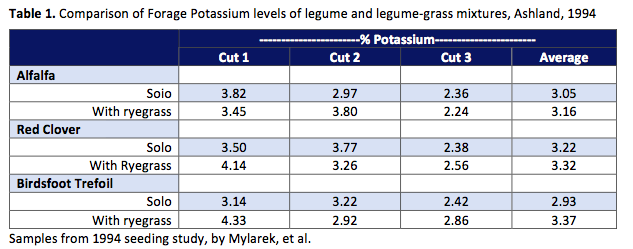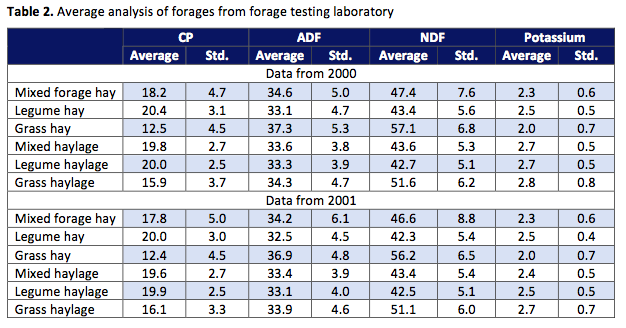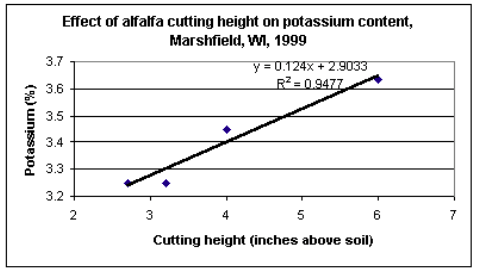
Getting Low Potassium in Forages
by Dan Undersander and Keith Kelling, University of Wisconsin
Hypocalcemia results from a deficiency in plasma Calcium at the onset of lactation in dairy cows, and is the main cause of several severe metabolic disorders. Three weeks prior to calving, it is desirable to have a moderately anionic diet, to avoid milk fever and hypocalcemia. Immediately after calving, a cationic diet is essential. High potassium forages (>2.5%) result in cationic diets and are not desirable to feed immediately prior to calving. The interest in low potassium forages has caused many to consider practices and expenses not justified based on our knowledge of forage growth and factors affecting potassium composition. The following points summarize the known facts concerning potassium content of forages.
- Cattle only need low potassium for three weeks prior to calving. During the transition period 3 to 4 weeks prior to calving, it is desirable to have a moderately anionic diet, to avoid milk fever and hypocalcemia. Immediately after calving, a cationic diet is essential. Milk high in potassium and milking dairy cattle can readily use high potassium concentrations in the forage.
- Soil test and add potassium only as recommended. Much of the high potassium in forages arises from adding potassium to soils without regard to soil test levels of potassium. Adding only recommended potassium will save money and result in lower potassium concentrations in forages.
- All forages, except corn silage, grown on same ground contain similar potassium levels at the same maturity. As the data in table 1 indicates, seeding ryegrass with alfalfa did not affect the potassium concentration of the harvested forage. Some national data bases of forage composition, such as those in the National Research Council requirements for dairy and beef animals, list lower potassium concentrations for some grasses than legumes. This simply means that grasses, on the average, are grown on lower potassium soils. In fact, grasses tend to be more efficient than legumes in their ability to extract K from the soil. For this reason, grasses will often be at or above tissue potassium levels reported for alfalfa when grown on the same soil. This is shown in table 2 where grass haylage has averaged the same to slightly higher potassium concentration than legumes and grass-legume mixtures for samples analyzed over the last two years. Grass hays were slightly lower than legume and mixture hays in potassium but this probably reflects greater maturity of the grass as indicated by the higher ADF levels. Adding a grass to your forage establishment mix will usually not result in lower tissue K levels of the harvested forage.


- Cut alfalfa close to ground. Potassium tends to be concentrated more in the stems than the leaves and is even more concentrated in the upper stems (Rominger et. al, 1975). Therefore, cutting low to include as much stem as possible will cause the resulting hay or haylage to be lower in potassium as shown in the figure below.

- Harvest more mature forage for dry cows. As legumes and grasses mature their potassium content declines. Alfalfa was found to decline from 2.75 % to nearly 1.75% potassium from late vegetative to one-fourth bloom (Baker and Reid, 1977). Similar work at UW Marshfield Research Station showed that from late vegetative to full bloom potassium levels in alfalfa dropped from 3.21 to 2.08%. At the same site, second node bromegrass to late heading dropped from 3.01 to 2.41 % potassium. Grasses at flowering may have half the potassium concentration of immature forage earlier in the season. This is also suggested by results for forage testing laboratories which indicate that grass haylage generally has higher potassium concentrations than grass hay which tends to be more mature.
- Rain on windrowed alfalfa significantly reduced potassium concentration. Potassium is not a part of any plant compound. It is in the cell soluble and therefore very readily leached from the plant. In 2002, 0.6 inches of rain reduced tissue potassium from 2.55 to 1.90% potassium (Kelling, personal communication, 2001).
- Low potassium forage can be generated on most farms by the above recommendations, however, if all fields test high for potassium, consider the following program recommended by Cherney and Cherney (2002) to grow low potassium forage:
- Select a small acreage which will not have manure applied to it. This can often be some distance from the barn to reduce overall hauling to remaining fields.
- Plant a long-lived grass, such as smooth bromegrass or reed canarygrass.
- Avoid all forms of K fertilization (No Manure).
- Grow for two years with no fertilization other than nitrogen to draw down the soil potassium.
- Use moderate to heavy N fertilization (75-100 lbs/acre/harvest).
- Harvest 2 times per year, first cutting at boot or early heading stage (early to mid-June) and mid-September.
- Use grass regrowth for cows close to calving, as it should be lowest in K content. Quality will be adequate for dry cows, not for milking cows.
- If K content of spring grass forage is below 1.7%, consider modest K fertilizer or manure additions after spring harvest (50-100 lbs potash or equivalent).
References
Baker, B.S. and R.L. Reid. 1977. Mineral concentration of forage species grown in central West Virginia on various soil series. West Virginia University Agric and Forestry exp. Stn. Bull 657.
Cherney, J.H. and D.J.R. Cherney. 2002. Grass Management for Dry Dairy Cows. Cornell University, unpublished.
Hoffman, P.C., D.W. Wiersma, and K.A. Kelling. 2002 Effect of maturity on the chemical and nutrient composition of selected forages. Soil Science and Plant Analysis (submitted)
Rominger, R.S. D. Smith, and L. A. Peterson. 1975. Yields and elemental composition of Alfalfa plant parts in late bud under two fertility levels. Can J. Plant Sci. 55: 69-75.
Wiersma, D.W. and J.B. Peters, 2000. Effect of Cutting height on alfalfa yield and tissue K levels. Proceedings of Wisconsin Fertilizer, Aglime, and Pest Management Conference. Vol 39 pp 381 to 386.



